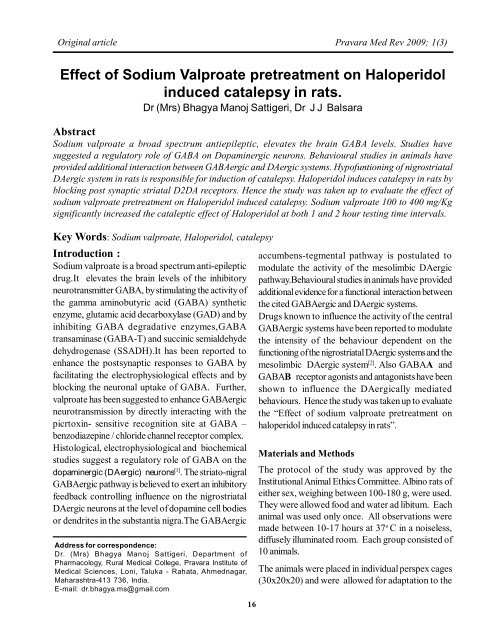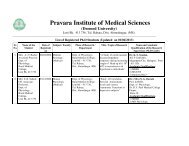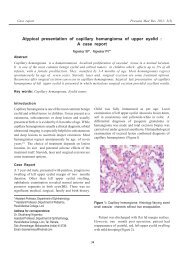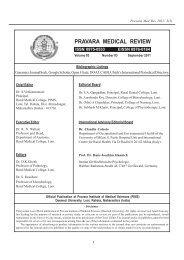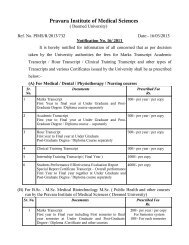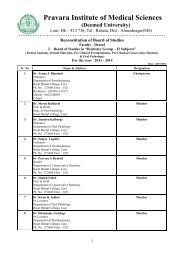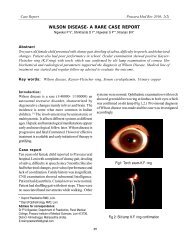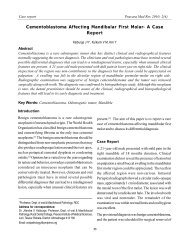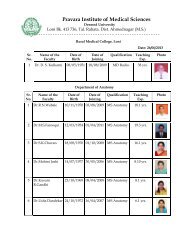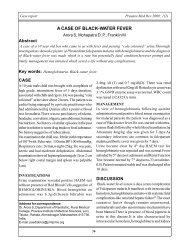(Mrs) Bhagya Manoj Sattigeri, Dr - Pravara Institute of Medical ...
(Mrs) Bhagya Manoj Sattigeri, Dr - Pravara Institute of Medical ...
(Mrs) Bhagya Manoj Sattigeri, Dr - Pravara Institute of Medical ...
Create successful ePaper yourself
Turn your PDF publications into a flip-book with our unique Google optimized e-Paper software.
Original article <strong>Pravara</strong> Med Rev 2009; 1(3)<br />
Effect <strong>of</strong> Sodium Valproate pretreatment on Haloperidol<br />
induced catalepsy in rats.<br />
<strong>Dr</strong> (<strong>Mrs</strong>) <strong>Bhagya</strong> <strong>Manoj</strong> <strong>Sattigeri</strong>, <strong>Dr</strong> J J Balsara<br />
Abstract<br />
Sodium valproate a broad spectrum antiepileptic, elevates the brain GABA levels. Studies have<br />
suggested a regulatory role <strong>of</strong> GABA on Dopaminergic neurons. Behavioural studies in animals have<br />
provided additional interaction between GABAergic and DAergic systems. Hyp<strong>of</strong>untioning <strong>of</strong> nigrostriatal<br />
DAergic system in rats is responsible for induction <strong>of</strong> catalepsy. Haloperidol induces catalepsy in rats by<br />
blocking post synaptic striatal D2DA receptors. Hence the study was taken up to evaluate the effect <strong>of</strong><br />
sodium valproate pretreatment on Haloperidol induced catalepsy. Sodium valproate 100 to 400 mg/Kg<br />
significantly increased the cataleptic effect <strong>of</strong> Haloperidol at both 1 and 2 hour testing time intervals.<br />
Key Words: Sodium valproate, Haloperidol, catalepsy<br />
Introduction :<br />
Sodium valproate is a broad spectrum anti-epileptic<br />
drug.It elevates the brain levels <strong>of</strong> the inhibitory<br />
neurotransmitter GABA, by stimulating the activity <strong>of</strong><br />
the gamma aminobutyric acid (GABA) synthetic<br />
enzyme, glutamic acid decarboxylase (GAD) and by<br />
inhibiting GABA degradative enzymes,GABA<br />
transaminase (GABA-T) and succinic semialdehyde<br />
dehydrogenase (SSADH).It has been reported to<br />
enhance the postsynaptic responses to GABA by<br />
facilitating the electrophysiological effects and by<br />
blocking the neuronal uptake <strong>of</strong> GABA. Further,<br />
valproate has been suggested to enhance GABAergic<br />
neurotransmission by directly interacting with the<br />
picrtoxin- sensitive recognition site at GABA –<br />
benzodiazepine / chloride channel receptor complex.<br />
Histological, electrophysiological and biochemical<br />
studies suggest a regulatory role <strong>of</strong> GABA on the<br />
dopaminergic (DAergic) neurons [1] . The striato-nigral<br />
GABAergic pathway is believed to exert an inhibitory<br />
feedback controlling influence on the nigrostriatal<br />
DAergic neurons at the level <strong>of</strong> dopamine cell bodies<br />
or dendrites in the substantia nigra.The GABAergic<br />
Address for correspondence:<br />
<strong>Dr</strong>. (<strong>Mrs</strong>) <strong>Bhagya</strong> <strong>Manoj</strong> <strong>Sattigeri</strong>, Department <strong>of</strong><br />
Pharmacology, Rural <strong>Medical</strong> College, <strong>Pravara</strong> <strong>Institute</strong> <strong>of</strong><br />
<strong>Medical</strong> Sciences, Loni, Taluka - Rahata, Ahmednagar,<br />
Maharashtra-413 736, India.<br />
E-mail: dr.bhagya.ms@gmail.com<br />
16<br />
accumbens-tegmental pathway is postulated to<br />
modulate the activity <strong>of</strong> the mesolimbic DAergic<br />
pathway.Behavioural studies in animals have provided<br />
additional evidence for a functional interaction between<br />
the cited GABAergic and DAergic systems.<br />
<strong>Dr</strong>ugs known to influence the activity <strong>of</strong> the central<br />
GABAergic systems have been reported to modulate<br />
the intensity <strong>of</strong> the behaviour dependent on the<br />
functioning <strong>of</strong> the nigrostriatal DAergic systems and the<br />
mesolimbic DAergic system [2] . Also GABAA and<br />
GABAB receptor agonists and antagonists have been<br />
shown to influence the DAergically mediated<br />
behaviours. Hence the study was taken up to evaluate<br />
the “Effect <strong>of</strong> sodium valproate pretreatment on<br />
haloperidol induced catalepsy in rats”.<br />
Materials and Methods<br />
The protocol <strong>of</strong> the study was approved by the<br />
Institutional Animal Ethics Committee. Albino rats <strong>of</strong><br />
either sex, weighing between 100-180 g, were used.<br />
They were allowed food and water ad libitum. Each<br />
animal was used only once. All observations were<br />
made between 10-17 hours at 37 o C in a noiseless,<br />
diffusely illuminated room. Each group consisted <strong>of</strong><br />
10 animals.<br />
The animals were placed in individual perspex cages<br />
(30x20x20) and were allowed for adaptation to the
Sattegeri B.M.: Effect <strong>of</strong> Sodium....... <strong>Pravara</strong> Med Rev 2009; 1(3)<br />
new environment. Animals were tested for catalepsy<br />
according to the method <strong>of</strong> Costall and Naylor [6] by<br />
placing both front limbs <strong>of</strong> the animal over an 8 cm<br />
high wooden block and measuring the time that the<br />
animals maintained this posture. The animals were<br />
considered cataleptic if they maintained this imposed<br />
posture for more than 10 secs.<br />
Animals were tested for catalepsy at 0.5,1,2,3 and 4<br />
hours after treatment with sodium. valproate (50 to 400<br />
mg/kg), haloperidol (1mg /kg) and normal saline (5ml/<br />
kg body weight ip, control group).<br />
Sodium valproate was injected one hour before<br />
haloperidol. Cataleptic scoring scheme modified from<br />
that <strong>of</strong> Costall and Naylor was as follows: Maintaining<br />
the cataleptic posture for 0-10 sec (0); 10-30 sec (1);<br />
30-60 sec (2) ; 1-2 min (3) ; 2 min and more [4] .<br />
Animals were tested for catalepsy at 1 and 2 hours<br />
after haloperidol treatment. Catalepsy score <strong>of</strong> each<br />
animal in the group was taken to compute the mean<br />
value <strong>of</strong> the group. The results were statistically analysed<br />
by the students unpaired t-test with differences<br />
considered significant at p < 0.05.<br />
Observations and Results<br />
Treatment dose mg/kg Catalepsy score at 1<br />
hour (Mean + SE)<br />
Catalepsy score at 2<br />
hour (Mean + SE)<br />
1. NS + HAL 0.5 1.0+ 0.00 0.8 + 0.13<br />
2. VAL 50 + HAL 0.5 1.1 + 0.10 0.9 + 0 .10<br />
3. VAL 100 + HAL 0.5 1.6 + 0.16* 1.4 + 0 .16*<br />
4. VAL 150 + HAL 0.5 1.9 + 0.10 ** 1.7 + 0 .15**<br />
5. VAL 200 + HAL 0.5 2.2 + 0.13*** 2.0 + 0 .00***<br />
6. VAL 300 + HAL 0.5 2.4 + 0.16*** 2.2 + 0 .13***<br />
7. VAL 400+ HAL 0.5 2.6 + 0.16*** 2.4 + 0 .16***<br />
Table 1:Effect <strong>of</strong> Valproate on haloperidol induced catalepsy(0.5mg/kg)<br />
1. NS + HAL 1 2.8 + 0.13 2.6 + 0.14<br />
2. VAL 50 + HAL 1 2.9 + 0.10 2.7 + 0 .15<br />
3. VAL 100 + HAL 1 3.4 + 0.16* 3.2+ 0 .3*<br />
4. VAL 150 + HAL 3.7 + 0.13** 3.5 + 0 .16**<br />
5. VAL 200 + HAL 1 4.0 + 0.00*** 3.8 + 0.13***<br />
*P < 0.05, ** P < 0.01, *** P < 0.001 NS = Normal saline (5ml/kg ip).<br />
Table 2: Effect <strong>of</strong> Valproate on haloperidol induced catalepsy(1mg/kg)<br />
Preliminary studies with sodium valproate (50 to 400<br />
mg / kg) did not induce catalepsy in rats. Haloperidol<br />
(0.5 and 1 mg/kg) induced dose dependent degree<br />
<strong>of</strong> catalepsy in rats at both 1 and 2 hour testing time<br />
intervals (Table 1).<br />
Pretreatment with 50 mg /kg sodium valproate did<br />
not significantly affect the cataleptic effect <strong>of</strong><br />
haloperidol (0.5 and 1 mg /kg) at both 1 and 2 hour<br />
testing time intervals. However pretreatment with 100<br />
to 400 mg/kg sodium valproate significantly increased<br />
the cataleptic effect <strong>of</strong> haloperidol (0.5 mg/kg) at both<br />
1 and 2 hour testing time intervals (Table 1). Similarly,<br />
pretreatment with 100, 150 and 200 mg/kg sodium<br />
valproate significantly enhanced the cataleptic effect <strong>of</strong><br />
1 mg/kg haloperidol at both 1 and 2 hours testing time<br />
intervals (Table 2).<br />
17
Sattegeri B.M.: Effect <strong>of</strong> Sodium....... <strong>Pravara</strong> Med Rev 2009; 1(3)<br />
The effect <strong>of</strong> pretreatment with 300 and 400 mg/kg<br />
sodium valproate on 1 mg /kg haloperidol induced<br />
catalepsy was not studied since pretreatment with 200<br />
mg/kg dose <strong>of</strong> sodium valproate had maximally<br />
potentiated the cataleptic effect <strong>of</strong> 1 mg/kg<br />
haloperidol (Table 2).<br />
Discussion<br />
Catalepsy is defined as a state <strong>of</strong> failure to correct the<br />
externally imposed posture. Hyp<strong>of</strong>unctioning <strong>of</strong> the<br />
nigrostriatal DAergic system in the rat with resultant<br />
functional lack <strong>of</strong> DA at the post synaptic striatal D2<br />
DA receptors, is responsible for induction <strong>of</strong> catalepsy.<br />
Neuroleptics,eg haloperidol induce catalepsy in the rats<br />
by blocking the post synaptic striatal D2 DA<br />
receptors [7] . GABA is present as a major<br />
neurotransmitter in all <strong>of</strong> the major efferent<br />
pathways,related to the nigrostriatal and the mesolimbic<br />
DAergic systems.<br />
It is evident with biochemical, electrophysiological and<br />
behavioral studies that GABA and GABA mimetic<br />
agents have complex influence on the functioning <strong>of</strong><br />
the nigrostriatal and mesolimbic DAergic<br />
systems.Biochemical studies have demonstrated that<br />
GABA – T inhibitor amino-oxyacetic acid (AOAA)<br />
inhibits DA turnover both in the striatum and the limbic<br />
system [8] and also inhibits the increase <strong>of</strong> striatal<br />
homovanillic acid (HVA) content induced by<br />
chlorpromazine [9] and haloperidol [10] .<br />
It has been reported that pretreatment with AOAA<br />
and bacl<strong>of</strong>en potentiated haloperidol induced catalepsy<br />
in rats [11] . Similarly, benzodiazepines muscimol, AOAA<br />
and diaminobutyric acid (DABA an inhibitor <strong>of</strong> GABA<br />
uptake) potentiated catalepsy induced by haloperidol<br />
(0.3 and 0.6 mg/kg ip) [12] . Potentiation <strong>of</strong> haloperidol<br />
catalepsy by muscimol, AOAA and DABA is due to<br />
elevated GABA levels, which stimulated the GABA<br />
receptors located on cell bodies <strong>of</strong> nigrostriatal DA<br />
ergic neurons, thereby decreasing the release <strong>of</strong> DA<br />
into the synaptic cleft.<br />
Further, Valproate (200, 300 and 400 mg/kg ), through<br />
the released 5-HT also inhibit the synthesis <strong>of</strong> DA and<br />
hence decrease the stores <strong>of</strong> DA in the nigrostriatal<br />
DAergic neurons and thus makes less DA available for<br />
release during the neuroleptic compensatory<br />
“feedback” increase <strong>of</strong> nigrostriatal DAergic neuronal<br />
activity. As a result the haloperidol induced blockade<br />
<strong>of</strong> post synaptic striatal D2 DA receptors is<br />
counteracted to a lesser extent with resultant<br />
potentiation <strong>of</strong> haloperidol catalepsy in rats.<br />
From the above observations it can be concluded that<br />
valproate potentiates haloperidol induced catalepsy in<br />
dose dependant manner. The potentiation has also been<br />
with both the doses <strong>of</strong> haloperidol.Since valproate is<br />
known to increase the GABA levels by various<br />
mechanisms,it is likely that the potentiation in<br />
cataleptic score could be associated with increased<br />
GABA level.This needs to be confirmrd by measuring<br />
GABA levels and DA levels at various sites in brain <strong>of</strong><br />
rats.<br />
REFERENCES<br />
1. Racagni G, Bruno F, Cattabeni F, Cattabeni F,<br />
Maggi A, Di Giulio AM, Parenti M, Groppetti<br />
A ; Functional interaction between rat substantia<br />
nigra and striatum; GABA and dopamine<br />
interrelation; Brain Res,1977, 134, 353-358.<br />
2. Guidotti A, Gale K, Hong J, T<strong>of</strong>fano G; In;<br />
‘Interactions between putative neurotrans<br />
mitters in the brain’,(Garattini S, Pujol JF,<br />
Samanin S Eds), 1978, p 217,Raven Press<br />
New York.<br />
3. Worms P, Willigens MT, Lloyd KG-“GABA<br />
involvement in neuroleptic induced catalepsy”<br />
: J Pharm Pharmacol, 1978,30, 716-718.<br />
4. Jones DL, Mogenson GJ, Wu M;” Neural<br />
projection from nucleus accumbens to globus<br />
pallidus,sustantia innominata and lateral<br />
preoptic,lateral hypothalamic area:An<br />
anatomical and electrophysiological<br />
investigations in the rat” : Neuropharmacology,<br />
1983,3, 189-202.<br />
5. Kuruvilla A, Uretsky NJ;”Effects <strong>of</strong> sodium<br />
valproate on motor fuction regulated by the<br />
18
Sattegeri B.M.: Effect <strong>of</strong> Sodium....... <strong>Pravara</strong> Med Rev 2009; 1(3)<br />
activation <strong>of</strong> GABA receptors”:<br />
Psychopharmacology, 1981,72, 167.<br />
6. Costall B, Naylor RJ;Mesolimbic involvement<br />
with behavioural effect indicating antipsychotic<br />
activity”: Eur J Pharmacol, 1974,27, 46.<br />
7. Ahlenius S;”Pharmacological evaluation <strong>of</strong><br />
new antipsychotic drugs; In ‘Behavioural<br />
Models in Psychopharmacology- Theoretical,<br />
Industrial and Clinical Perspectives’, 1991,<br />
edited by Paul Willner, Cambridge University<br />
Press, Cambridge, p311.<br />
8. Anden NE;“Inhibition <strong>of</strong> the turn over <strong>of</strong> the<br />
brain dopamine after treatment with the gamma<br />
amino butyrate:2-Oxygluterate transaminase<br />
inhibitor amino oxyacetic acid”: Naunyn<br />
Schmiedeberg’s Arch Pharmacol,1974, 283,<br />
419-424.<br />
9. Lahti RA, Losey EG; Antagonism <strong>of</strong> the effects<br />
<strong>of</strong> chlorpromazine and morphine on<br />
dopamine metabolism by GABA” : Res Comm<br />
Chem Pathol Pharmac,1974, 7, 31-40<br />
10. Westerink BHC, Korf J;”Dopamine release in<br />
substantia nigra”: Eur J Pharmacol,1975, 33,<br />
31-40<br />
11. Kaariainen I;” Effect <strong>of</strong> aminooxyacetic acid<br />
and bacl<strong>of</strong>en on the catalepsy and on the<br />
increase <strong>of</strong> mesolimbic and striatal dopamine<br />
turn over induced by haloperidol in rats” : Acta<br />
Pharmacol Toxicol,l976, 39, 393-400<br />
12. Keller HH, Schafffner R, Haefely W;”<br />
Selective antagonists <strong>of</strong> benzodiazepines”:<br />
Naunyn Schmiedeberg’s Arch Pharmacol,<br />
1976, 294,1-7.<br />
19


